Possibilities for Developing Electromobility by Using Autonomously Powered Trolleybuses Based on the Example of Gdynia
Abstract
1. Introduction
1.1. Developing Electromobility in Public Transport Systems
1.2. Scientific Background of the Trolleybus Transport Research
1.3. The Idea of Autonomous Trolleybuses
- charging at night—the bus runs all day without recharging;
- main charging at night, one-time recharging during the day;
- using a plug-in system: an electric bus is recharged many times a day, usually when the bus is at the terminus or at bus stops [87].
1.4. Arguments in Favour of Developing Public Transport with the Use of Partially Autonomous Trolleybuses
1.5. Research Goals
- are partially autonomous trolleybuses an alternative to electric buses?
- is it possible to develop connections effectively by electrifying bus lines having the trolleybus overhead line infrastructure at one’s disposal?
- what is the optimal level of coverage of a bus line with OHL to meet the conditions for its operation with partially autonomous trolleybuses?
- what is the impact of congestion on the designed size of traction batteries in trolleybuses?
- what is the minimum power of the charger to charge a battery in a trolleybus?
2. Materials and Methods
- Ech_IMC—energy delivered during dynamic charging
- Ech_st—energy delivered during stationary charging.
- laut—driving range on battery power
- tOHL—driving time with power supply from the overhead line
- tst—stationary charging time
- e—energy consumption
- PIMC—charging power
- PIMC_6min—IMC charging power, assuming a 6-min stop at the terminus
- PIMC_0—IMC charging power assuming no stop at the terminus
3. Study Area—The Case Study of Gdynia in Poland
3.1. Operating Conditions
3.2. Experience in Using Autonomous Trolleybuses in Gdynia
4. Research Analysis
5. Interpretation of Research Results
- the minimum power of the vehicle charger, which determines whether the vehicle will be able to charge the traction battery;
- the maximum driving range on battery power, which determines the minimum capacity of the traction battery;
- sensitivity coefficient c, which determines the extent to which the battery will be charged in the dynamic mode and the stationary mode. This coefficient carries information about the sensitivity of the charging process to congestion; greater sensitivity means a need to increase the capacity of the traction battery in the event of traffic disruptions.
6. Conclusions
- -
- -
- determination of the minimum charging power in IMC system for various variants of the OHL (Figure 10, Equations (1)–(5));
- -
- determination of the sensitivity coefficient for individual variants (Figure 11, Equation (6));
- -
- assessment of the possibility of electrification using various conditions based on the results of the calculations (Figure 12).
- the functioning of classic trolleybus transport supported by modern IMC solutions is an alternative to electric buses. No advantages were identified of introducing electric buses to operate the city’s transport system with trolleybuses and OHL infrastructure. The advantage of IMC trolleybuses is the fact that they have relatively small on-board batteries, which in the long run affects the costs of maintenance and operation;
- IMC technology has a positive effect on the spatial development of zero-emission transport. There is no need to build OHL in peripheral areas, with low population density or in places where it is not possible to build it, so this has a positive effect on the economic balance and offers access to electrified transport for most of the city’s inhabitants;
- The length of the bus line section under the OHL infrastructure, which is only 20–25%, makes it suitable for servicing by IMC trolleybuses;
- in the case of the Gdynia case study, it was identified that street congestion, which takes place mainly in the city centre and on the main streets where OHL is installed, has a positive effect on the functioning of IMC trolleybuses, because a longer drive under OHL has a positive effect on the process of charging on-board batteries;
- the optimal value of the charger power for IMC trolleybuses is 150 kW or 100 kW in the case of extension of the traction infrastructure. However, it should be assumed that a sufficient value is 150 kW.
Author Contributions
Funding
Institutional Review Board Statement
Informed Consent Statement
Data Availability Statement
Acknowledgments
Conflicts of Interest
References
- Santos, G. Road transport and CO2 emissions: What are the challenges? Transp. Policy 2017, 59, 71–74. [Google Scholar] [CrossRef]
- Zhang, R.; Fujimori, S. The role of transport electrification in global climate change mitigation scenarios. Environ. Res. Lett. 2020, 15, 034019. [Google Scholar] [CrossRef]
- New Transport Decarbonisation Alliance for Faster Climate Action. Available online: https://unfccc.int/news/new-transport-decarbonisation-alliance-for-faster-climate-action (accessed on 11 April 2021).
- Decarbonising Transport Initiative. Available online: https://www.itf-oecd.org/decarbonising-transport (accessed on 11 April 2021).
- European Commission. Communication from the Commission to the European Parliament, the European Council, the Council, the European Economic and Social Committee and the Committee of the Regions, The European Green Deal, COM (2019) 640 Final; European Commission: Brussels, Belgium, 2019. [Google Scholar]
- European Commission. Communication from the Commission to the European Parliament, the Council, the European Economic and Social Committee and the Committee of the Regions, Sustainable and Smart Mobility Strategy–Putting European Transport on Track for the Future, COM (2020) 789 Final; European Commission: Brussels, Belgium, 2020. [Google Scholar]
- Directive 2014/94/EU of the 22 October 2014 on the Deployment of Alternative Fuels Infrastructure. Available online: https://eur-lex.europa.eu/legal-content/en/TXT/?uri=CELEX%3A32014L0094 (accessed on 20 March 2021).
- National Framework for the Policy of Development of Alternative Fuel Infrastructure. Resolution of the Council of Ministers from 29 March 2017. Available online: https://www.gov.pl/attachment/c3db2c7c-adc7-4b56-9bae-be4ec1e48683 (accessed on 20 March 2021).
- Act on Electromobility and Alternative Fuels from 11 January 2018. Journal of Laws of 2018, item 317. Available online: https://isap.sejm.gov.pl/isap.nsf/download.xsp/WDU20180000317/U/D20180317Lj.pdf (accessed on 20 March 2021).
- National Center for Research and Development. Polska na Drodze do Elektromobilności; ZDG TOR: Warsaw, Poland, 2018. [Google Scholar]
- Wierzbowski, M.; Filipiak, I.; Łyżwa, W. Polish energy policy 2050—An instrument to develop a diversified and sustainable electricity generation mix in coal-based energy system. Renew. Sustain. Energy Rev. 2017, 74, 51–70. [Google Scholar] [CrossRef]
- Tomaszewski, K. The Polish road to the new European Green Deal—Challenges and threats to the national energy policy. Energy Policy J. 2020, 23, 5–18. [Google Scholar] [CrossRef]
- Zawieska, J. E-mobility in transport and climate policies of European Union and Poland. In E-Mobility: Visions and Development Scenarios; Gajewski, J., Paprocki, W., Pieriegud, J., Eds.; Coalition for Strategic Mindset: Sopot, Poland, 2017; pp. 23–39. [Google Scholar]
- Zawieska, J.; Pieregud, J. Smart city as a tool for sustainable mobility and transport decarbonization. Transp. Policy 2018, 63, 39–50. [Google Scholar] [CrossRef]
- Połom, M.; Wiśniewski, P. Implementing electromobility in public transport in Poland in 1990–2010. A review of experiences and evaluation of the current development directions. Sustainability 2021, 13, 4009. [Google Scholar] [CrossRef]
- Wołek, M.; Wolański, M.; Bartłomiejczyk, M.; Wyszomirski, O.; Grzelec, K.; Hebel, K. Ensuring sustainable development of urban public transport: A case study of the trolleybus system in Gdynia and Sopot (Poland). J. Clean. Prod. 2021, 279, 123807. [Google Scholar] [CrossRef]
- Costa, Á.; Fernandes, R. Urban public transport in Europe: Technology diffusion and market organization. Transp. Res. Part. A 2012, 46, 269–284. [Google Scholar] [CrossRef]
- Trolley: Motion. Urban E-Mobility. Available online: https://www.trolleymotion.eu/ (accessed on 11 April 2021).
- BVG Berlin Plans Implementation of Hybrid Trolleybuses. Available online: https://www.urban-transport-magazine.com/en/bvg-berlin-plans-implementation-of-hybrid-trolleybuses/ (accessed on 11 April 2021).
- Six Van Hool Battery-Electric Trolleybuses Headed to Pescara (Italy) with New IMC System. Available online: https://www.sustainable-bus.com/news/trolleybuses-pescara-van-hool/ (accessed on 11 April 2021).
- Praha Chce 20 Kloubových Trolejbusů Pro Linku na Letiště. Available online: https://www.cs-dopravak.cz/2019-9-30-praha-chce-20-kloubovch-trolejbus-pro-linku-na-letit/ (accessed on 10 March 2021).
- Praha Může Postavit Trolejbusovou Trať až do Miškovic, má Stavební Povolení. Available online: https://zdopravy.cz/praha-muze-postavit-trolejbusovou-trat-az-do-miskovic-ma-stavebni-povoleni-75403/ (accessed on 10 April 2021).
- Is It a Bus, Is It a Train? It’s MetroNeo, the Newest Mass Transport System for Nashik. Available online: https://indianexpress.com/article/explained/metroneo-rail-maharashtra-nashik-transport-7171793/ (accessed on 11 April 2021).
- Alfieri, L.; Bracale, A.; Caramia, P.; Iannuzzi, D.; Pagan, M. Optimal battery sizing procedure for hybrid trolley-bus: A real case study. Electr. Power Syst. Res. 2019, 175, 105930. [Google Scholar] [CrossRef]
- Bartłomiejczyk, M. Practical application of In Motion Charging: Trolleybuses service on bus lines. In Proceedings of the 2017 18th International Scientific Conference on Electric Power Engineering (EPE), Loučná nad Desnou, Czech Republic, 17–19 May 2017; pp. 676–681. [Google Scholar] [CrossRef]
- Bartłomiejczyk, M.; Połom, M. Nowoczesna koncepcja rozwoju transportu trolejbusowego—Projekt Slide-In. Autobusy Tech. Eksploat. Syst. Transp. 2015, 7–8, 2–35. [Google Scholar]
- Bartłomiejczyk, M.; Połom, M. Dynamic Charging of Electric Buses as a Way to Reduce Investment Risks of Urban Transport System Electrification. In TRANSBALTICA XI: Transportation Science and Technology: Proceedings of the International Conference TRANSBALTICA; Gopalakrishnan, K., Prentkovskis, O., Jackiva, I., Junevičius, R., Eds.; Springer Nature Switzerland AG: Cham, Switzerland, 2020; pp. 297–308. [Google Scholar] [CrossRef]
- Berckmans, G.; Messagie, M.; Smekens, J.; Omar, N.; Vanhaverbeke, L.; Van Mierlo, J. Cost Projection of State of the Art Lithium-Ion Batteries for Electric Vehicles Up to 2030. Energies 2017, 10, 1314. [Google Scholar] [CrossRef]
- Bergk, F.; Biemann, K.; Lambrecht, U.; Pütz, R.; Landinger, H. Potential of In-Motion Charging Buses for the Electrification of Urban Bus Lines. J. Earth Sci. Geotech. Eng. 2016, 6, 347–362. [Google Scholar]
- Gao, Z.; Lin, Z.; LaClair, T.J.; Liu, C.; Li, J.-M.; Birky, A.K.; Ward, J. Battery capacity and recharging needs for electric buses in city transit service. Energy 2017, 122, 588–600. [Google Scholar] [CrossRef]
- Lenz, E. Electric bus with IMC from Kiepe Electric: Reliable, simple and more cost effective. Fachmag. V+T Verk. Tech. 2017, 8–9. [Google Scholar]
- Połom, M.; Bartłomiejczyk, M. Alternatywne źródła zasilania w trolejbusach–Przegląd rozwiązań stosowanych w miastach europejskich. Transp. Miej. I Reg. 2011, 8, 16–20. [Google Scholar]
- Rogge, M.; Wollny, S.; Sauer, D.U. Fast Charging Battery Buses for the Electrification of Urban Public Transport—A Feasibility Study Focusing on Charging Infrastructure and Energy Storage Requirements. Energies 2015, 8, 4587–4606. [Google Scholar] [CrossRef]
- Wołek, M.; Szmelter-Jarosz, A.; Koniak, M.; Golejewska, A. Transformation of Trolleybus Transport in Poland. Does In-Motion Charging (Technology) Matter? Sustainability 2020, 12, 9744. [Google Scholar] [CrossRef]
- Hołyszko, P.; Filipek, P.Z. Estimation of the running costs of autonomous energy sources in trolleybuses. J. Ecol. Eng. 2016, 17, 101–106. [Google Scholar] [CrossRef]
- Jeong, S.; Jang, Y.J.; Kum, D. Economic Analysis of the Dynamic Charging Electric Vehicle. IEEE Trans. Power Electron. 2015, 30, 6368–6377. [Google Scholar] [CrossRef]
- Pietrzak, K.; Pietrzak, O. Environmental Effects of Electromobility in a Sustainable Urban Public Transport. Sustainability 2020, 12, 1052. [Google Scholar] [CrossRef]
- Yusof, N.K.; Abas, P.E.; Mahlia, T.M.I.; Hannan, M.A. Techno-Economic Analysis and Environmental Impact of Electric Buses. World Electr. Veh. J. 2021, 12, 31. [Google Scholar] [CrossRef]
- Klucininkas, L.; Matulevicius, J.; Martuzevicius, D. The life cycle assessment of alternative fuel chains for urban buses and trolleybuses. J. Environ. Manag. 2012, 99, 98–103. [Google Scholar] [CrossRef] [PubMed]
- Lajunen, A. Lifecycle costs and charging requirements of electric buses with different charging methods. J. Clean. Prod. 2018, 172, 56–67. [Google Scholar] [CrossRef]
- Potkány, M.; Hlatká, M.; Debnár, M.; Hanzl, J. Comparison of the lifecycle cost structure of electric and diesel buses. Naše More 2018, 65, 270–275. [Google Scholar] [CrossRef]
- Sheth, A.; Sarkar, D. Life Cycle Cost Analysis for Electric vs. Diesel Bus Tansit in an Indian Scenario. Life 2019, 10, 105–115. [Google Scholar] [CrossRef]
- Czermański, E. Economic aspects of trolleybus transport in Europe. Experiences of TROLLEY project, Central Europe Programme. J. Int. Sci. Publ. Econ. Bus. 2013, 7, 471–483. [Google Scholar]
- Czermański, E. Analiza kosztowa wybranych systemów trolejbusowych na bazie projektu TROLLEY. Autobusy Tech. Eksploat. Syst. Transp. 2013, 14, 2063–2074. [Google Scholar]
- Dębicka, O.; Czermański, E. The cost of trolleybus transport. In The Trolleybus as an Urban Means of Transport in the Light of the Trolley Project; Wołek, M., Wyszomirski, O., Eds.; Wydawnictwo Uniwersytetu Gdańśkiego: Gdańsk, Poland, 2013; pp. 90–107. [Google Scholar]
- Pietrzak, O.; Pietrzak, K. The Economic Effects of Electromobility in Sustainable Urban Public Transport. Energies 2021, 14, 878. [Google Scholar] [CrossRef]
- Jarzmik, M. Aktualne wymagania inwestycyjne przy budowie nowej zajezdni komunikacji miejskiej–na przykładzie Przedsiębiorstwa Komunikacji Trolejbusowej Sp. z o.o. w Gdyni. Biul. Komun. Miej. 2008, 99, 48–52. [Google Scholar]
- Bartłomiejczyk, M.; Połom, M. The impact of the overhead line’s power supply system spatial differentiation on the energy consumption of trolleybus transport: Planning and economic aspects. Transport 2017, 32, 1–12. [Google Scholar] [CrossRef][Green Version]
- Bartłomiejczyk, M.; Dombrowski, J.; Połom, M.; Wyszomirski, O. Conversion of a Diesel Engine Bus into a Trolleybus; Zakład Poligrafii Fundacji Rozwoju Uniwersytetu Gdańskiego: Gdańsk, Poland, 2012; pp. 1–82. [Google Scholar]
- Taczanowski, J.; Kołoś, A.; Gwosdz, K.; Domański, B.; Guzik, R. The development of low-emission public urban transport in Poland. Bull. Geogr. Socio-Econ. Ser. 2018, 41, 79–82. [Google Scholar] [CrossRef]
- Połom, M.; Turżański, B. Doświadczenia Solaris Bus & Coach w produkcji trolejbusów. Autobusy Tech. Eksploat. Syst. Transp. 2011, 18, 42–49. [Google Scholar]
- Połom, M.; Turżański, B.; Bartłomiejczyk, M. Produkcja i sprzedaż trolejbusów Solaris Trollino w latach 2011–2014. Autobusy Tech. Eksploat. Syst. Transp. 2015, 22, 8–12. [Google Scholar]
- Połom, M. International Relations on the Market of Trolleybus’ Manufacturers in Europe in the Years 2000–2014. Stud. Ind. Geogr. Comm. Pol. Geogr. Soc. 2016, 30, 75–90. [Google Scholar]
- Bedell, R. A Practical, 70–90% Electric Bus without Overhead Wires. In Proceedings of the EVS24 Conference, Stavanger, Norway, 13–16 May 2009; pp. 1–7. [Google Scholar]
- Brdulak, A.; Chaberek, G.; Jagodziński, J. Development Forecasts for the Zero-Emission Bus Fleet in Servicing Public Transport in Chosen EU Member Countries. Energies 2020, 13, 4239. [Google Scholar] [CrossRef]
- Krawiec, S.; Łazarz, B.; Markusik, S.; Karoń, G.; Sierpiński, G.; Krawiec, K. Urban public transport with the use of electric buses–development tendencies. Transp. Probl. 2016, 11, 127–137. [Google Scholar] [CrossRef][Green Version]
- Kühne, R. Electric buses–An energy efficient urban transportation means. Energy 2010, 35, 4510–4513. [Google Scholar] [CrossRef]
- Bogusławski, J. Gdynia rozbudowuje sieć trolejbusową. Transp. Miej. I Reg. 2006, 1, 27–31. [Google Scholar]
- Brunton, L.J. Why not the trolleybus. In Electric, Hybrid and Fuel Cell Vehicles; IEEE Seminar: 5/1–5/7; IET: Durham, UK, 2000. [Google Scholar]
- Göhlich, D.; Fay, T.-A.; Jefferies, D.; Lauth, E.; Kunith, A.; Zhang, X. Design of urban electric bus systems. Des. Sci. 2018, 4, 1–28. [Google Scholar] [CrossRef]
- Tsolas, I.E. Performance Evaluation of Electric Trolley Bus Routes. A Series Two-Stage DEA Approach. Infrastructures 2021, 6, 44. [Google Scholar] [CrossRef]
- Borowik, L.; Cywiński, A. Modernization of a trolleybus line system in Tychy as an example of eco-efficient initiative towards a sustainable transport system. J. Clean. Prod. 2016, 117, 188–198. [Google Scholar] [CrossRef]
- Połom, M. Projekt rewitalizacji i rozwoju komunikacji trolejbusowej w Gdyni współfinansowany ze środków unijnych. Transp. Miej. I Reg. 2011, 6, 25–30. [Google Scholar]
- Hebel, K. Kierunki rozwoju komunikacji trolejbusowej w świetle wyników badań marketingowych w Gdyni. Logistyka 2012, 3, 787–792. [Google Scholar]
- Jagiełło, A.; Gałka, P. Impact of changes in organization of trolleybus line no. 29 in Gdynia on passangers’ travel behavior. Transp. Econ. Logist. 2017, 70, 109–117. [Google Scholar] [CrossRef]
- Biresselioglu, M.E.; Kaplan, M.D.; Yilmaz, B.K. Electric mobility in Europe: A comprehensive review of motivators and barriers in decision making processes. Transp. Res. Part A 2018, 109, 1–13. [Google Scholar] [CrossRef]
- Cansino, J.M.; Sánchez-Braza, A.; Sanz-Díaz, T. Policy Instruments to Promote Electro-Mobility in the EU28: A Comprehensive Review. Sustainability 2018, 10, 2507. [Google Scholar] [CrossRef]
- Chertkovskaya, E.; Paulsson, A. The end of the line: Envisioning degrowth and ecosocial justice in the resistance to the trolleybus dismantlement in Moscow. Local Environ. 2021, 1–19. [Google Scholar] [CrossRef]
- Dyr., T. Wsparcie rozwoju transportu publicznego z funduszy strukturalnych w pierwszym okresie członkostwa Polski w Unii Europejskiej. Transp. Miej. I Reg. 2006, 9, 2–10. [Google Scholar]
- Khorovitch, B. The trolleybus in a modern city: State-of-the-art and future perspectives. Public Transp. Int. 2004, 53, 53–57. [Google Scholar]
- Kołoś, A.; Taczanowski, J. Fundusze europejskie jako czynnik rozwoju miejskiego transportu szynowego w Polsce. Pr. Kom. Geogr. Komun. Ptg 2016, 19, 9–20. [Google Scholar] [CrossRef]
- Krawiec, S.; Krawiec, K. Rozwój elektromobilności w Polsce. Uwarunkowania, cele i bariery. Zesz. Nauk. Uniw. Ekon. W Katowicach 2017, 332, 17–21. [Google Scholar]
- Lejda, K.; Mądziel, M.; Siedlecka, S.; Zielińska, E. The future of public transport in light of solutions for sustainable transport development. Sci. J. Sil. Univ. Technol. Ser. Transp. 2017, 95, 97–108. [Google Scholar] [CrossRef]
- Mathieu, L. Electric Buses Arrive on Time—Marketplace, Economic, Technology, Environmental and Policy Perspectives for Fully Electric Buses in the EU; European Federation for Transport and Environment: Brussels, Belgium, 2018. [Google Scholar]
- Pejšova, M. Environmentally Friendly Public Transport. Trans. Transp. Sci. 2014, 7, 153–160. [Google Scholar] [CrossRef]
- Perujo, A.; Van Grootveld, G.; Scholz, H. Present and Future Role of Battery Electrical Vehicles in Private and Public Urban transport. In New Generation of Electric Vehicles; Stevic, Z., Ed.; InTech: Rijeka, Croatia, 2012; pp. 3–25. [Google Scholar]
- Petkov, D. The uneven development path of Bulgarian trolleybus transport—Leading back to the future? Case Stud. Transp. Policy 2020, 8, 1383–1392. [Google Scholar] [CrossRef]
- Połom, M. Przemiany Funkcjonowania Komunikacji Trolejbusowej w Polsce w Latach 1989–2013; Wydawnictwo Bernardinum: Pelplin, Poland, 2019; pp. 1–284. [Google Scholar]
- Rădulescu, V.; Străinescu, I.; Moroianu, L.; Tudor, E.; Gheorghe, S.; Goia, C. Urban electrical vehicles as the solution for public transportation in the cities of Romania. Urban Transp. 2011, XVII, 449–458. [Google Scholar]
- Tucki, K.; Orynycz, O.; Świć, A.; Mitoraj-Wojtanek, M. The Development of Electromobility in Poland and EU States as a Tool for Management of CO2 Emissions. Energies 2019, 12, 2942. [Google Scholar] [CrossRef]
- Wołek, M. Transport trolejbusowy w kształtowaniu zrównoważonej mobilności miejskiej na przykładzie Gdyni. Autobusy Tech. Eksploat. Syst. Transp. 2013, 7–8, 42–46. [Google Scholar]
- Brazis, V.; Latkovskis, L.; Grigans, L. Simulation of trolleybus traction induction drive with supercapacitor energy storage system. Latv. J. Phys. Tech. Sci. 2010, 47, 33–47. [Google Scholar] [CrossRef]
- Hutyria, S.; Chanchin, A.; Yaglinskyi, V.; Khomiak, Y.; Popov, V. Evolution of trolley-bus: Directions, indicators, trends. Diagnostyka 2020, 21, 11–26. [Google Scholar] [CrossRef]
- Krawiec, K. Proces wprowadzania autobusów elektrycznych do eksploatacji w przedsiębiorstwach komunikacji miejskiej–wybrane zagadnienia. Pr. Nauk. Politech. Warsz. 2016, 112, 217–226. [Google Scholar]
- Molecki., A. Zasilanie liniowe w aspekcie rozwoju branży autobusów elektrycznych. Autobusy Tech. Eksploat. Syst. Transp. 2018, 7–8, 28–32. [Google Scholar] [CrossRef]
- Paul, T.; Yamada, H. Operation and charging scheduling of electric buses in a city bus route network. In Proceedings of the 17th International IEEE Conference on Intelligent Transportation Systems (ITSC), Qingdao, China, 8–11 October 2014; pp. 2780–2786. [Google Scholar] [CrossRef]
- An Updated Overview of Electric Buses in Europe; ZeEUS eBus Report #2; Zero Emission Urban Bus System: Brussels, Belgium, 2018.
- Pacuk, M.; Anisiewicz, R.; Czochański, J.; Kopeć, K.; Połom, M.; Michalski, T.; Tarkowski, M. Gdynia w Unii Europejskiej. Warunki Życia; Wydawnictwo Bernardinum: Pelplin, Poland, 2016; pp. 1–211. [Google Scholar]
- Połom, M. European Union Funds as a Growth Stimulant of Electromobility on the Example of Electric Public Transport in Poland. Barom. Reg. Anal. I Progn. 2015, 13, 89–96. [Google Scholar]
- Połom, M.; Palmowski, T. Rozwój i Funkcjonowanie Komunikacji Trolejbusowej w Gdyni; Wydawnictwo Bernardinum: Pelplin, Poland, 2009; pp. 1–152. [Google Scholar]
- Połom, M.; Bartłomiejczyk, M. Promocja elektrycznego transportu miejskiego. Projekt Trolley. Autobusy Tech. Eksploat. Syst. Transp. 2011, 12, 42–45. [Google Scholar]
- Rulaff, M. Projekt Trolley jako przykład promowania ekologicznego transportu zbiorowego. Zesz. Nauk. Politech. Poznańskiej. Organ. I Zarz. 2013, 60, 89–96. [Google Scholar]
- Wołek, M. Projekt TROLLEY jako platforma współpracy środowisk transportowych w Europie Środkowo-Wschodniej. Autobusy Tech. Eksploat. Syst. Transp. 2012, 13, 16–18. [Google Scholar]
- Połom, M. Trends in the development of trolleybus transport in Poland at the end of the second decade of the 21st century. Pr. Kom. Geogr. Komun. Ptg 2018, 21, 44–59. [Google Scholar] [CrossRef]
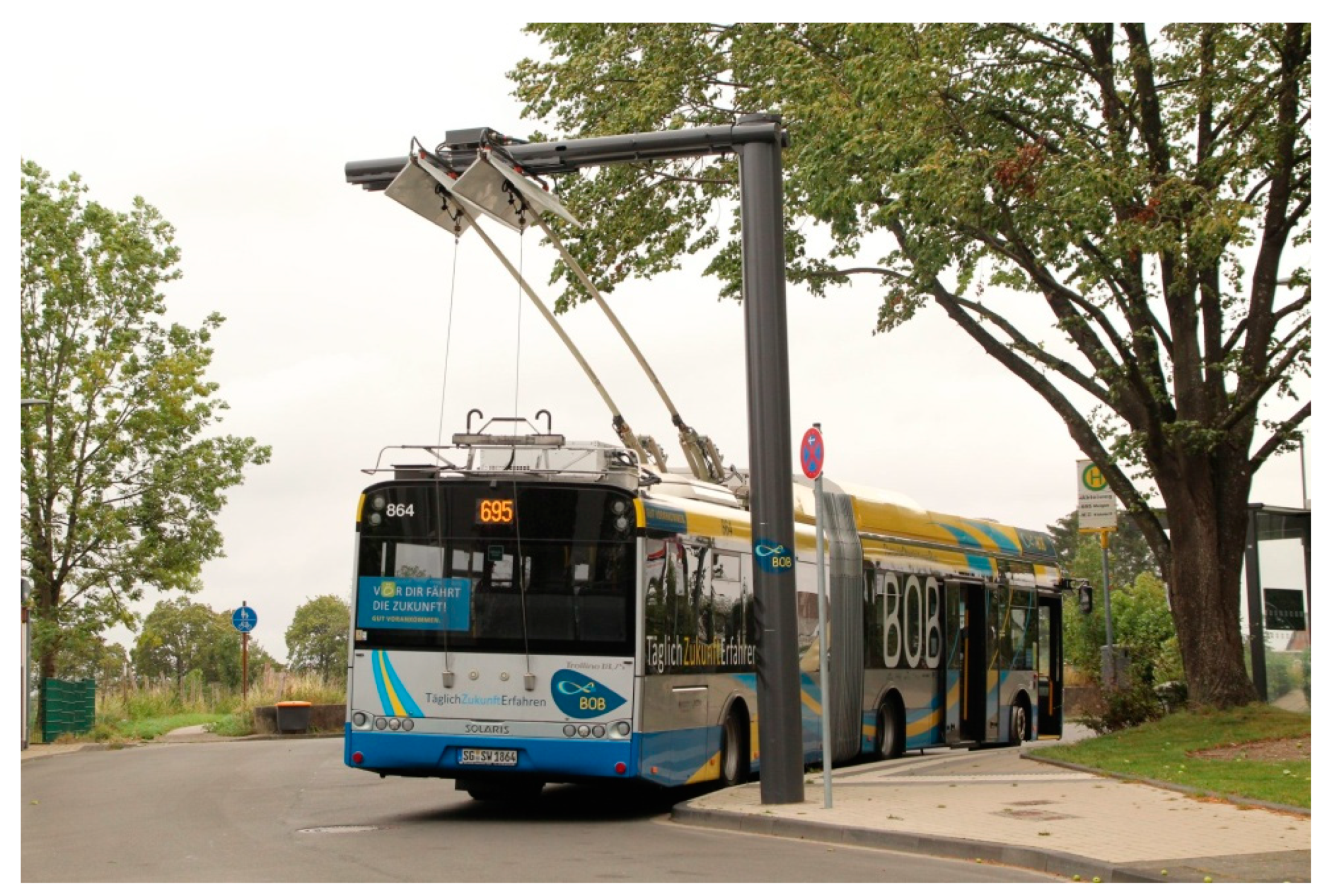
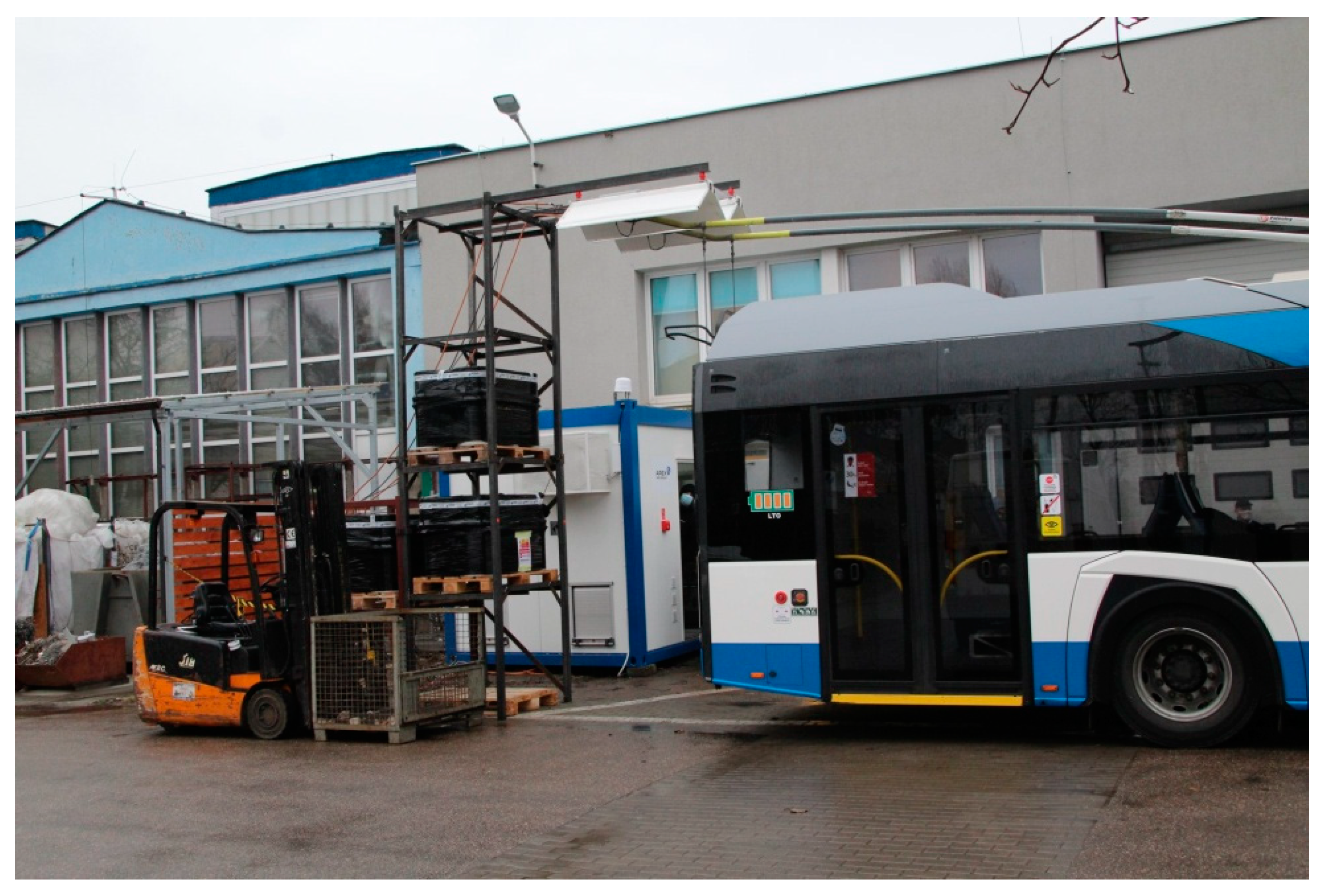


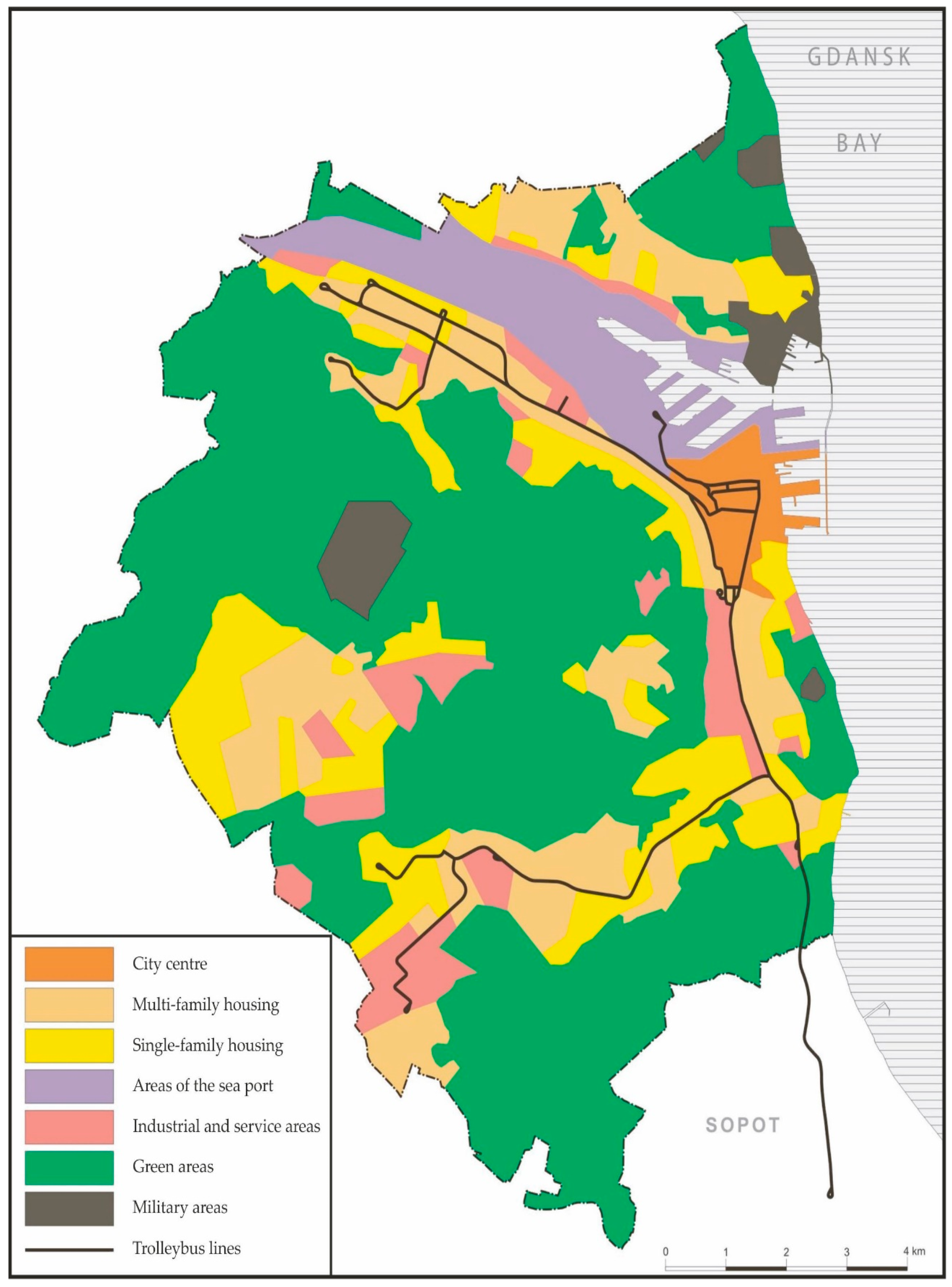

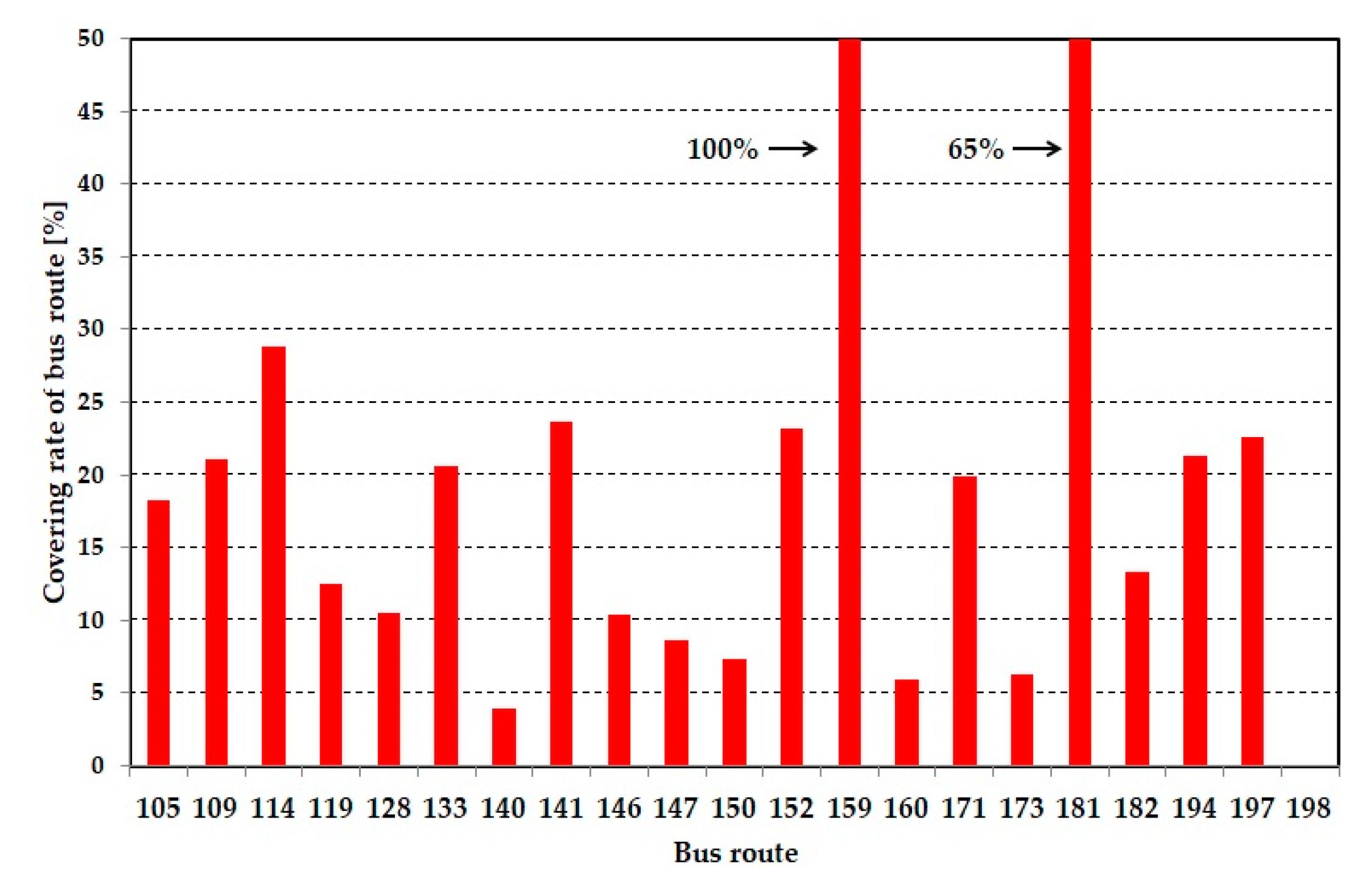
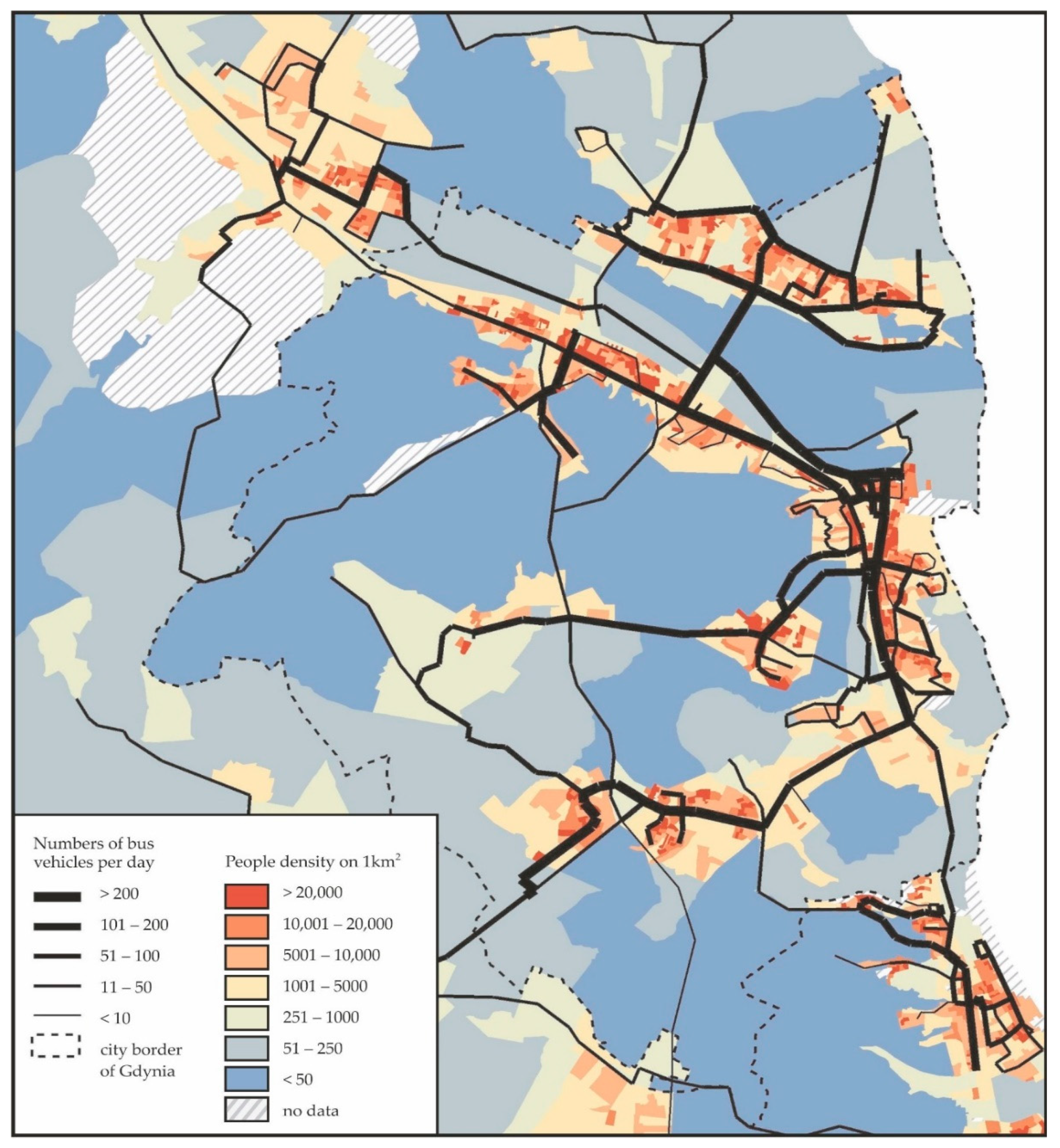
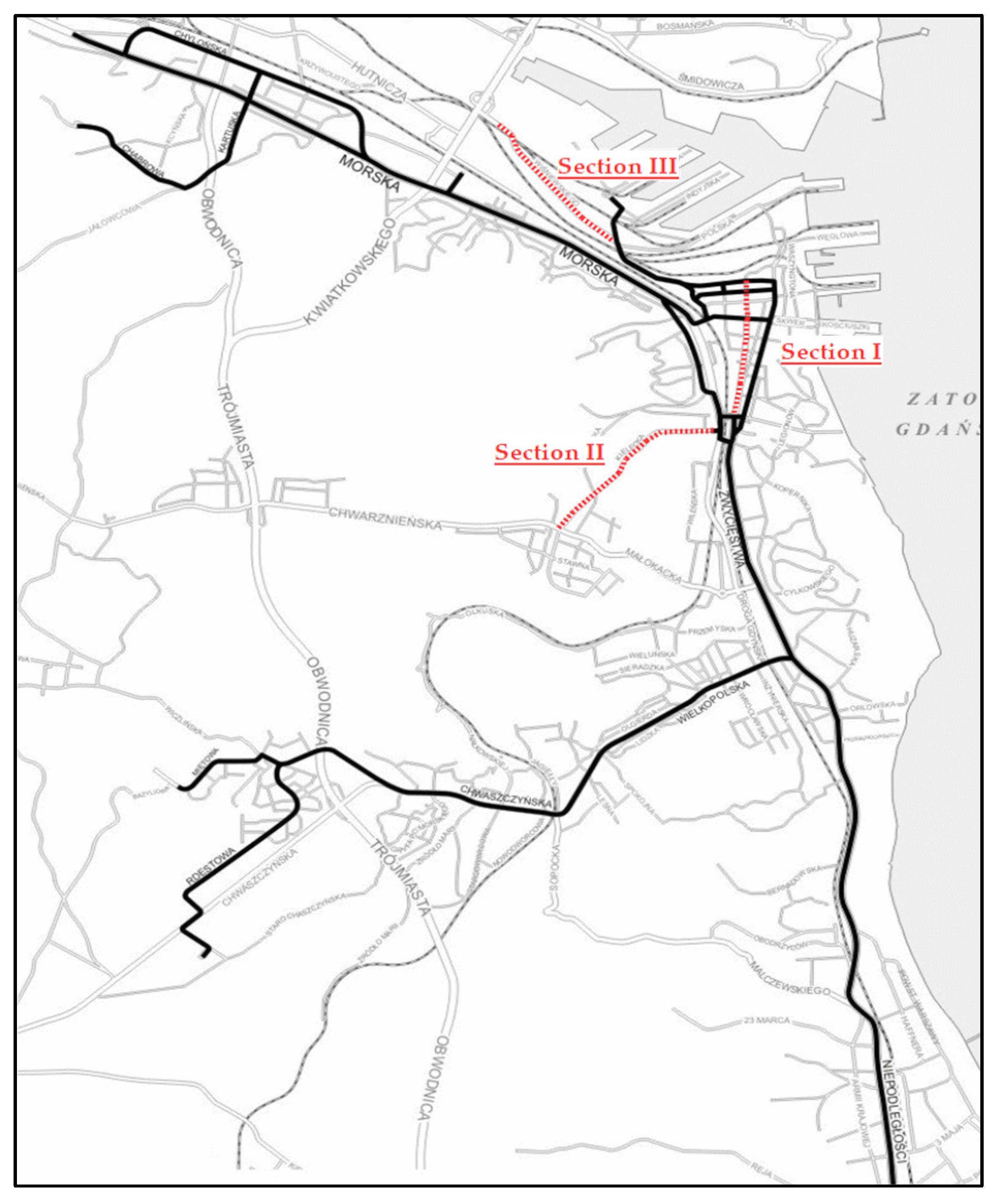
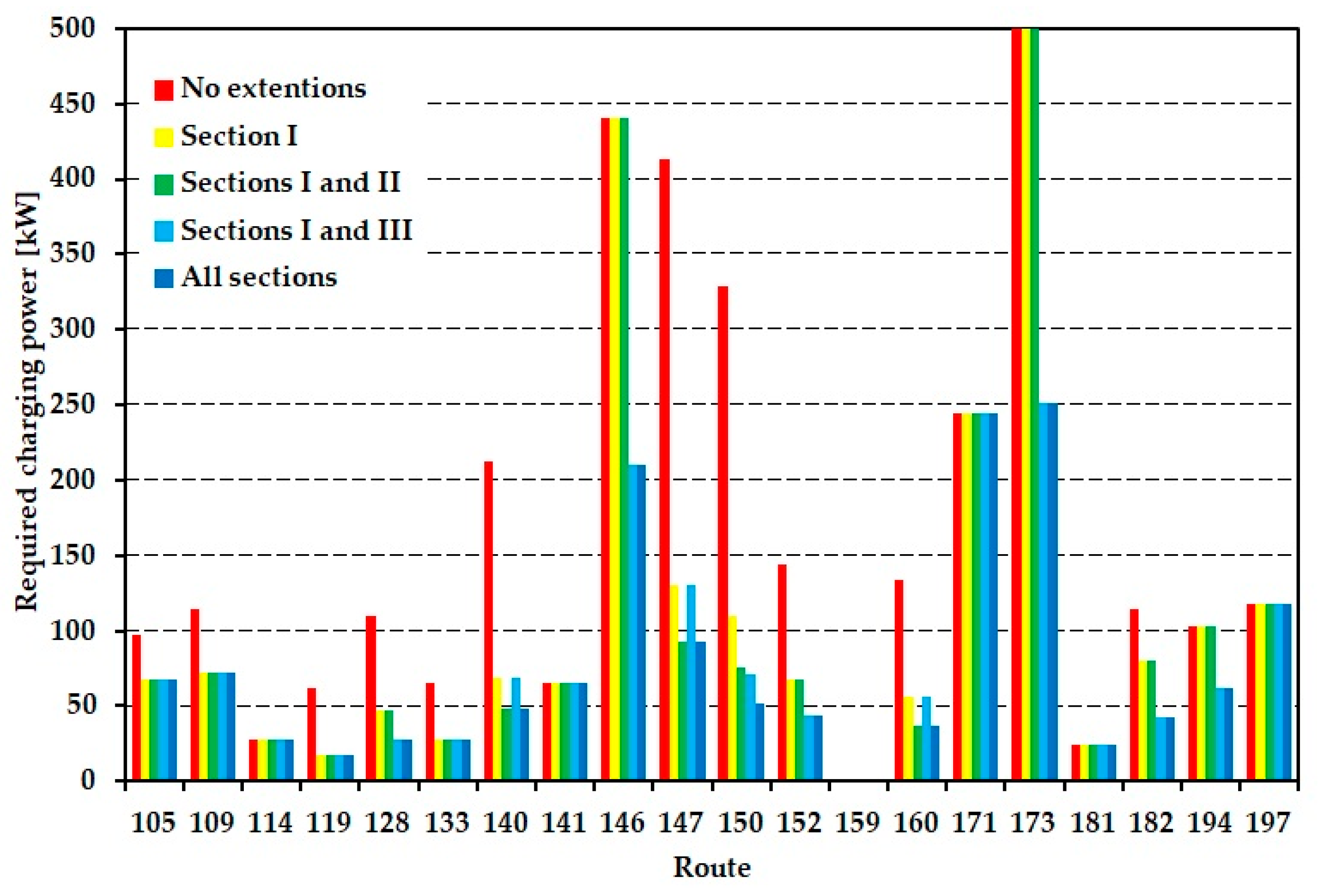
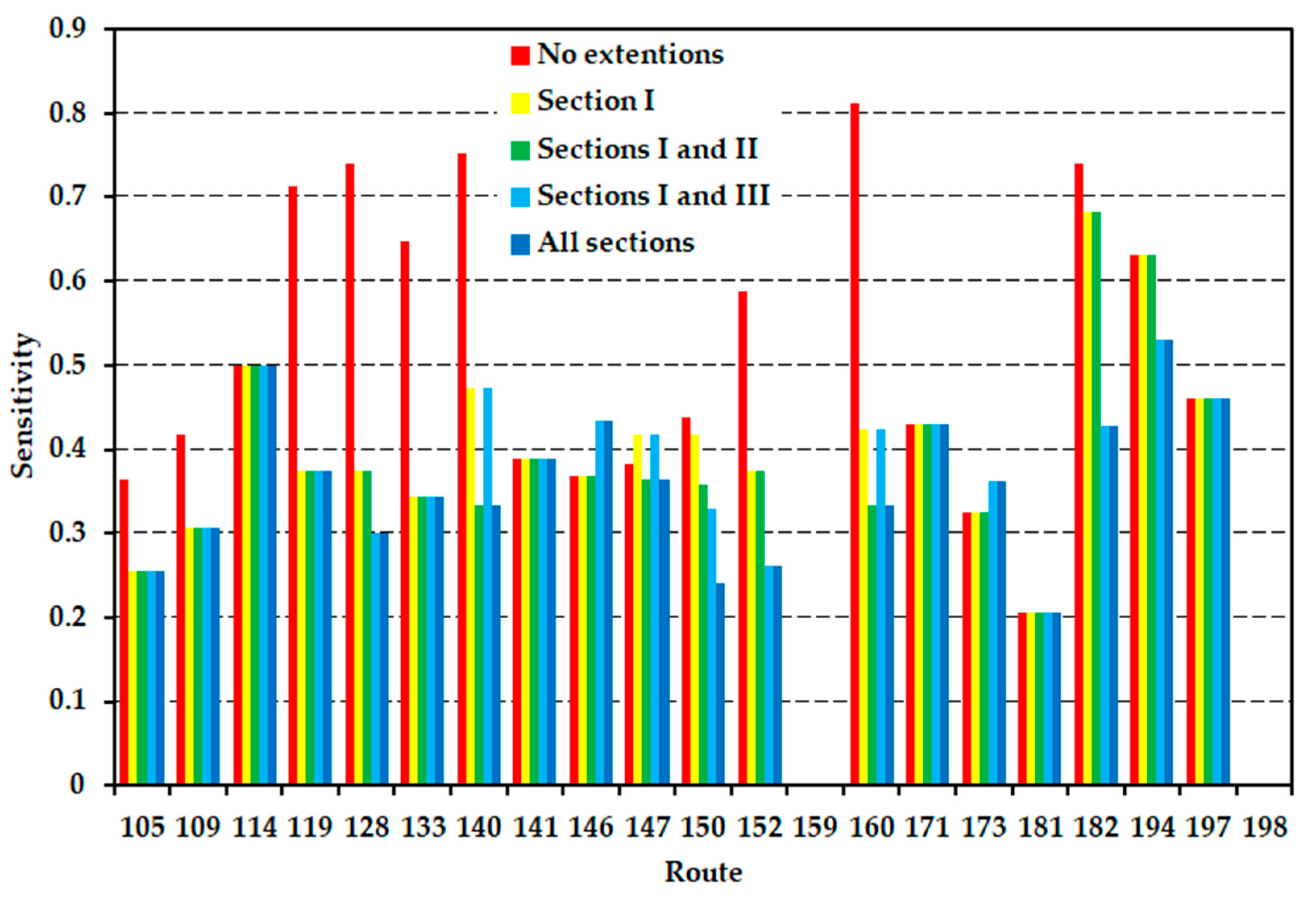

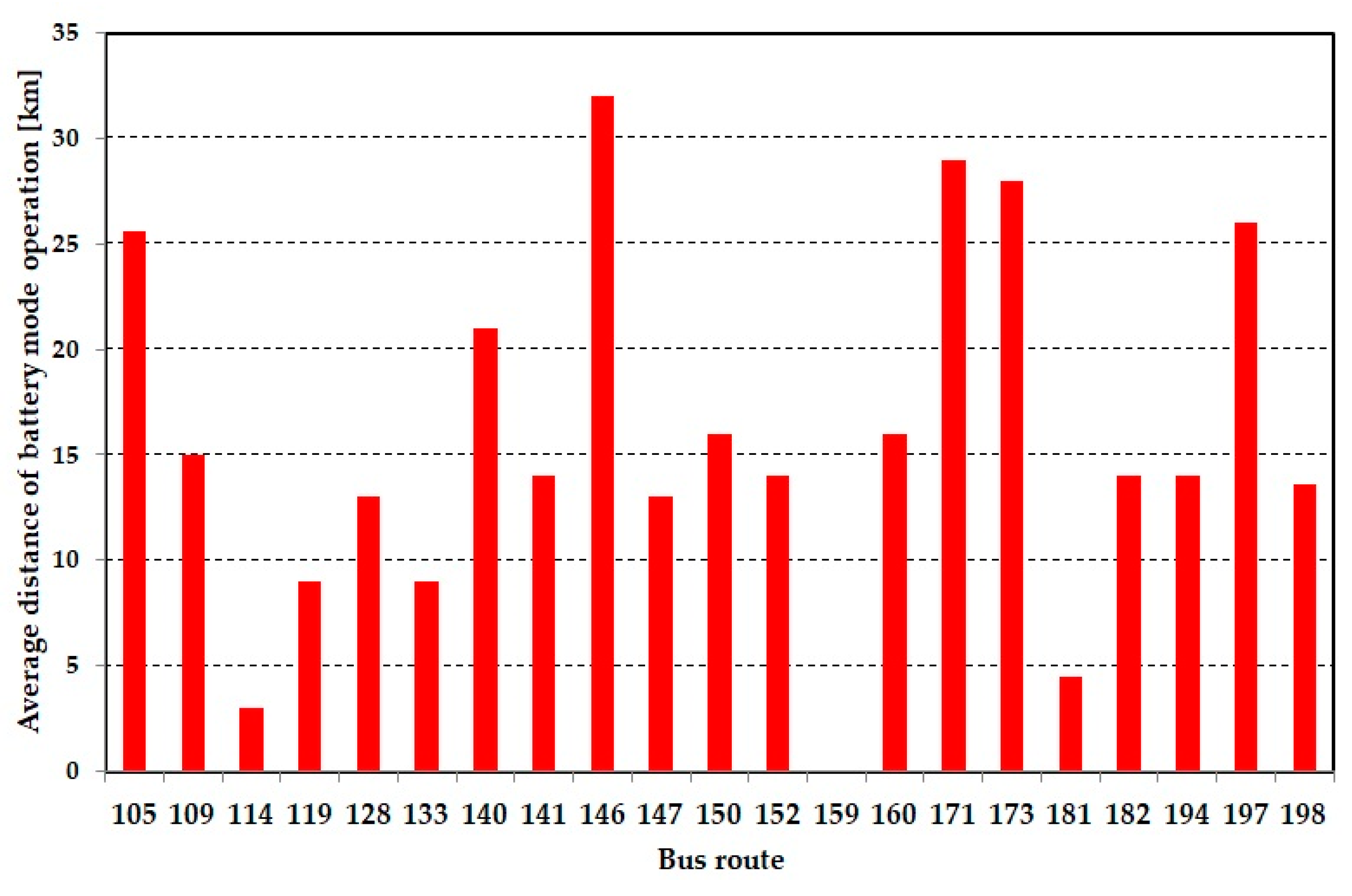
| Subject | Detailed Issue | Source |
|---|---|---|
| Auxiliary power sources | Battery | Alfieri et al. [24]; Bartłomiejczyk [25]; Bartłomiejczyk, Połom [26]; Bartłomiejczyk, Połom [27]; Berckmans et al. [28]; Berigk et al. [29]; Gao et al. [30]; Lenz [31]; Połom, Bartłomiejczyk [32]; Rogge et al. [33]; Wołek et al. [34] |
| Diesel unit | Połom, Bartłomiejczyk [32] | |
| Supercapacitor | Połom, Bartłomiejczyk [32] | |
| Financial efficiency of using auxiliary power sources | Hołyszko, Filipek [35]; Jeong et al. [36] | |
| Environmental impact | Environmental challenges | Santos [1]; Zhang, Fujimori [2] |
| Holistic studies of the environmental impact of electric public transport | Pietrzak, Pietrzak [37]; Yusof et al. [38] | |
| Financial cost | Life cycle operating costs | Klucininkas et al. [39]; Lajunen [40]; Potkány et al. [41]; Sheth, Sarkar [42] |
| Operating costs | Czermański [43]; Czermański [44]; Dębicka, Czermański [45]; Pietrzak, Pietrzak [46] | |
| Infrastructure | Depot | Jarzmik [47] |
| Power system | Bartłomiejczyk, Połom [48] | |
| Manufacture of trolleybuses | Conversion of a diesel bus into a trolleybus | Bartłomiejczyk et al. [49] |
| Production of new vehicles | Taczanowski et al. [50] | |
| Trolleybus rolling stock market | Połom, Turżański [51]; Połom et al. [52]; Połom [53] | |
| Organisation of trolleybus transport | Comparative studies of various means of transport | Bedell [54]; Brdulak et al. [55]; Krawiec et al. [56]; Kühne [57] |
| Designing new lines | Bogusławski [58]; Brunton [59]; Göhlich et al. [60]; Tsolas [61], Wołek et al. [16] | |
| Modernisation of infrastructure and rolling stock | Borowik, Cywiński [62]; Połom [63] | |
| Social research | Hebel [64]; Jagiełło, Gałka [65] | |
| Transport policy | Biresselioglu et al. [66]; Cansino et al. [67]; Chertkovskaya, Paulsson [68]; Costa, Fernandes [17]; Dyr [69], Khorovitch [70], Kołoś, Taczanowski [71], Krawiec, Krawiec [72], Lejda et al. [73], Mathieu [74], Pejšova [75], Perujo et al. [76], Petkov [77], Połom [78], Połom, Wiśniewski [15], Rădulescu et al. [79], Tomaszewski [12], Tucki et al. [80], Wołek [81] | |
| Technical aspects | Drive | Brazis et al. [82]; Hutyria et al. [83] |
| Technical conditions for designing connections in electric public transport | Krawiec [84], Molecki [85], Paul, Yamada [86] |
| Section | Route Description | Length | Additional Investment Required |
|---|---|---|---|
| Section I | Władysława IV | 2 km | - |
| Sections II | Kielecka (Wzgórze—Witomino Centrum) | 1.8 km | Placing power cables |
| Sections III | Janka Wiśniewskiego to Energetyków | 1.9 km | Placing power cables and constructing a new substation |
| Variant | Opportunities and Benefits | Public Transport Routes |
|---|---|---|
| No extensions | Line service with trolleybuses without investment | 114, 159, 181 |
| Line service with trolleybuses after the construction of fast charging stations | 109, 141, 194 | |
| Line service with trolleybuses after the construction of fast charging stations and increasing the battery capacity 1 | 105, 197 | |
| Line service with trolleybuses in the electric bus mode after the construction of fast charging stations | 119, 128, 133 | |
| Section I | Line service with trolleybuses after the construction of fast charging stations | 140, 147, 150, 152, 160, 182 |
| Decreasing the battery capacity 2 | 105, 109, 119, 128, 133 | |
| Sections I and II | Decreasing the battery capacity 3 | 140, 147, 150, 160 |
| Sections I and III | Decreasing the battery capacity 3 | 150, 152, 182, 194 |
Publisher’s Note: MDPI stays neutral with regard to jurisdictional claims in published maps and institutional affiliations. |
© 2021 by the authors. Licensee MDPI, Basel, Switzerland. This article is an open access article distributed under the terms and conditions of the Creative Commons Attribution (CC BY) license (https://creativecommons.org/licenses/by/4.0/).
Share and Cite
Bartłomiejczyk, M.; Połom, M. Possibilities for Developing Electromobility by Using Autonomously Powered Trolleybuses Based on the Example of Gdynia. Energies 2021, 14, 2971. https://doi.org/10.3390/en14102971
Bartłomiejczyk M, Połom M. Possibilities for Developing Electromobility by Using Autonomously Powered Trolleybuses Based on the Example of Gdynia. Energies. 2021; 14(10):2971. https://doi.org/10.3390/en14102971
Chicago/Turabian StyleBartłomiejczyk, Mikołaj, and Marcin Połom. 2021. "Possibilities for Developing Electromobility by Using Autonomously Powered Trolleybuses Based on the Example of Gdynia" Energies 14, no. 10: 2971. https://doi.org/10.3390/en14102971
APA StyleBartłomiejczyk, M., & Połom, M. (2021). Possibilities for Developing Electromobility by Using Autonomously Powered Trolleybuses Based on the Example of Gdynia. Energies, 14(10), 2971. https://doi.org/10.3390/en14102971







